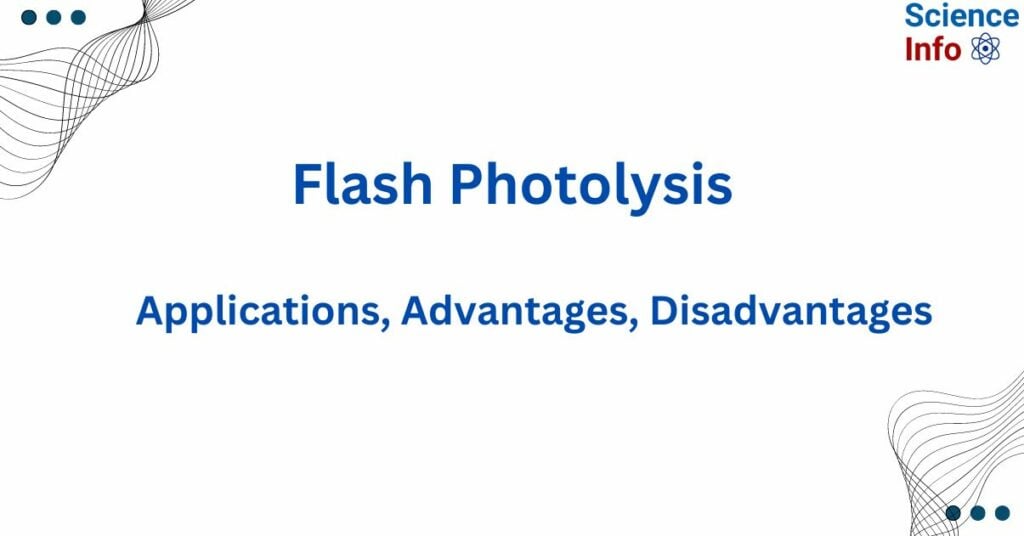
Flash photolysis was created to investigate short-lived intermediates. In 1967, Manfred Eigen, Ronald George, George Porter, and Wreyford Norrish received the Nobel Prize in Chemistry for co-discovering Flash Photolysis in 1949. They invented this method to examine short-lived intermediates in photoinduced processes.
Flash Photolysis is often used to analyze reactions that occur incredibly quickly i.e., fast reactions.
Flash Photolysis is commonly used to examine light-dependent reactions such as photosynthesis and reactions in the cones on our retina, but this method can also be used for other reactions.
The flash photolysis system can quantify transient absorption in the nanosecond range. The absorption spectrum reveals the creation and decay of intermediates in photoreactions including photodissociation and photoisomerization.
New software and optics make it possible to measure transient absorption spectra in nanosecond time intervals.
The original method of flash photolysis involved exciting the sample with an intense flash of light from a xenon tube, followed by a spectroscopic flash of lower intensity from a second flash tube, the light from which was detected using a photographic plate. The photolysis flash generates intermediates ( for example radicals, ions, isomers, etc.,) in the sample, that absorb light from the spectroscopic flash based on their concentration. Absorbance can be determined as:
𝐴= ɛcl
where A is the sample absorbance, ɛ is the molar absorption coefficient, c is the concentration, and l is the path length. Absorbance is related to incident and transmission intensities as
𝐴=log10 I0 /I
For a homogeneous absorber, the intensity falls off exponentially with path length when I0 is the incident intensity and I is the transmitted intensity. As a result, by monitoring the evolution of the absorption spectra, the changes in concentration of the photoproduced intermediates, as well as the kinetics of the processes in which they are involved, can be determined.
Flash photolysis is confined to transparent objects in its traditional geometry since the absorption spectra must be monitored to probe the excited species.
Many biological systems and industrially relevant samples are opaque or heavily scattered, so the Beer-Lambert law no longer accurately describes light attenuation through the sample.
The classic flash photolysis approach is limited by its flash duration, which is often larger than 1 ps. There is a need to reach periods shorter than this, notably to monitor and investigate the absorption of excited singlet states, which typically have lifetimes of nanoseconds. The introduction of the Q-switched laser has provided a mechanism for this purpose, and photoelectric detection methods have already been utilized in various laboratories to examine transients in the nanosecond range.
Interesting Science Videos
Laser flash photolysis
Laser flash photolysis spectroscopy is a commonly used tool for studying fundamental phenomena such as the formation of charge carriers, fast recombination, and interfacial transfer kinetics. In flash photolysis investigations, the laser pulse can cause the production of transitory species, which is frequently accompanied by a change in the original optical properties of the examined material. This change is spectroscopically evaluated using a flash lamp, which measures the transmittance of transparent materials and the reflectance of opaque samples before and after laser excitation.
The optical changes caused by laser stimulation in semiconductors are typically attributed to the creation of free and trapped electrons and holes. The examined sample is assumed to undergo no irreversible structural changes when illuminated with a strong laser pulse.
Laser Flash Photolysis examines the transient absorption of chemical and biological molecules caused by a short intense light pulse from a pulsed laser source.
This powerful light pulse generates photo-excited intermediates with limited lifetimes, including excited states, radicals, and ions. All of these intermediates are produced in sufficient concentrations to allow for chemical and physical interaction, as well as direct observation of the associated temporally shifting absorption characteristics. These absorption shifts are recorded in a single-beam absorption spectrometer with a spectrally continuous Xenon lamp (‘probe source’) as the background. The probe source is pulsed to increase photon flux for measurements over short time intervals.
Things to consider while measuring:
• Excitation should occur where ground-state absorption occurs.
• Laser pulse must be half the length of the reaction.
• Excitation requires sufficient energy.
• The flash must cover the spectrum of frequencies being covered. •
The flash produces unknown intermediates and is a source of spectroscopic analysis
Applications
- Flash photolysis is commonly used to study reaction kinetics, determining rate constants and mechanisms for chemical and biochemical reactions.
- It is also used to study photochemical reactions like photodissociation, photoisomerization, and photoreduction, which are important in fields like atmospheric chemistry, photobiology, and materials science.
- Laser flash photolysis is increasingly being utilized to investigate bioinorganic reaction mechanisms, such as electron transport in cytochromes and ligand binding by haem-containing proteins.
- The Flash Photolysis approach has recently been used to study the structural changes that functional proteins undergo throughout their activity.
- Researchers employ flash photolysis facilities extensively to investigate light-induced processes in organic molecules, polymers, nanoparticles, semiconductors, plant photosynthesis, signaling, and light-induced conformational changes in biological systems.
Advantages
- Flash photolysis provides exceptional temporal resolution, enabling researchers to study reactions as fast as picoseconds or milliseconds.
- It does not disrupt the system under examination. The process is initiated by light, leaving the molecules unaffected by any physical probes.
- Applicable to gaseous, liquid, and solid systems.
- Adaptable to numerous experimental settings, suitable for studying simple and complex reactions.
- Specific molecules or molecular bonds can be selectively activated using the right wavelength of light, allowing for the investigation of specific reaction pathways.
Disadvantages
- Flash photolysis focuses on light-induced processes. This excludes non-photochemically initiated processes.
- Detecting and characterizing flash photolysis intermediates is challenging due to their short lifespan. Specialized detecting procedures are frequently required.
- Performing a flash photolysis experiment demands specialized equipment and experience.
References
- https://chem.libretexts.org/Bookshelves/Physical_and_Theoretical_Chemistry_Textbook_Maps/Supplemental_Modules_(Physical_and_Theoretical_Chemistry)/Kinetics/02%3A_Reaction_Rates/2.01%3A_Experimental_Determination_of_Kinetics/2.1.04%3A_Relaxation_Methods/2.1.4.01%3A_Flash_Photolysis.
- https://jiwaji.edu/pdf/ecourse/chemistry/Chemical%20Kinetics.pdf
- https://web.mit.edu/10.652/www/GeorgePorterNobelLecture.pdf
- https://royalsocietypublishing.org/doi/abs/10.1098/rspa.1950.0018
- https://www.sciencedirect.com/topics/chemistry/flash-photolysis
- https://luzchem.com/products/laser-flash-photolysis
- https://pubs.rsc.org/en/content/articlelanding/2017/fd/c6fd00193a
